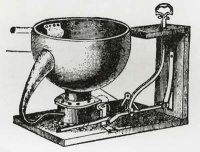In 1596, Sir John Harrington, an English courtier, made a significant contribution to sanitation and hygiene by inventing the flush toilet. Harrington was a prolific writer, poet, and godson of Queen Elizabeth I, but his invention of the flush toilet remains one of his most enduring legacies.
At the time, sanitation conditions in England were far from ideal. Chamber pots and primitive latrines were common, leading to unsanitary conditions and the spread of diseases. Harrington recognized the need for a more efficient and hygienic solution to waste disposal, which prompted him to develop the first flush toilet.
Harrington's design incorporated many innovative features that were ahead of its time. His flush toilet consisted of a bowl connected to a cistern filled with water, which was released with the pull of a lever. This mechanism allowed the waste to be swiftly and cleanly flushed away, preventing the accumulation of waste in the bowl. Harington also incorporated a valve system to regulate water flow and prevent overflow.
While Harrington's invention was a breakthrough, it was not without its challenges. The plumbing infrastructure of the time was not yet developed enough to support widespread adoption of the flush toilet. Additionally, his invention faced resistance due to societal taboos and the high cost of implementation.
Despite these challenges, Harrington's invention gained recognition and popularity among the elite circles of society. He installed one of his flush toilets in his own home, as well as in the palace of Queen Elizabeth I. He even wrote a satirical book titled "A New Discourse upon a Stale Subject: The Metamorphosis of Ajax" in 1596, in which he humorously described the use and benefits of his flush toilet.
Unfortunately, Harrington's invention did not immediately revolutionize sanitation practices across England. It would take several centuries for the flush toilet to become a standard fixture in households and public spaces. However, his pioneering work laid the foundation for future advancements in plumbing and sanitation.
It wasn't until the 19th century that the flush toilet gained widespread acceptance and became an integral part of modern plumbing systems. Innovations and improvements were made to Harrington's original design, and the technology was refined over time. The flush toilet ultimately transformed sanitation practices, greatly improving public health and hygiene.
Today, flush toilets are a ubiquitous feature in households, offices, and public spaces worldwide. They have become an essential part of modern life, making Sir John Harrington's invention a pivotal milestone in the history of sanitation and plumbing. His innovative thinking and dedication to improving public health continue to impact society to this day.
